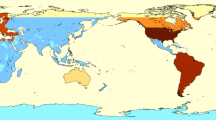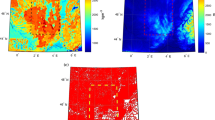Abstract
The Global Geopotential Models (GGMs) are very significant because of their usefulness in determination of the parameters like geoidal undulations, height anomalies, gravity anomalies, and so on. In this paper, first, we review the calculation of such parameters and then present the GGMCalc software, which is prepared in Fortran 95 under GNU/Linux Operating System. This software is capable of using the files presented by the International Center for Global Earth Models (ICGEM) directly without need to apply any changes on them. The software is completely structural and user friendly and could be used conveniently for academic purposes.








Similar content being viewed by others
References
Ardalan AA, Grafarend EW (2004) High-resolution regional geoid computation without applying Stokes’s formula case study: high resolution geoid of Iran. J Geod 78:138–156
Barthelms F (2009) Definition of functional of the geopotential and their calculation from spherical harmonic models. Scientific Technical Report STR09/02, Helmholtz Zentrum, Potsdam
Beutler G, Jäggi A, Meyer U, Prange L, Bock H, Dach R, Mervart L (2011) Gravity Field Determination at AIUB: From CHAMP and GRACE to GOCE. Presented at the 2011 General Assembly of the European Geosciences Union, Vienna, Austria
Bruinsma SL, Marty JC, Balmino G, Biancale R, Foerste C, Abrikosov O, Neumayer H (2010) GOCE gravity field recovery by means of the direct numerical method. Presented at the ESA Living Planet Symposium 2010, Bergen, June 27–July 2, Bergen, Noway
Casotto S, Fantino E (2007) Evaluation of methods for spherical harmonic synthesis of the gravitational potential and its gradients. Adv Space Res 40(1):69–75
Colombo O (1981) Numerical methods for harmonic analysis on the sphere, Report no 310. Dept. of Geodetic Science and Surveying, The Ohio State University
Förste C, Flechtner F, Schmidt R, Stubenvoll R, Rothacher M, Kusche J, Neumayer KH, Biancale R, Lemoine JM, Barthelmes F, Bruinsma J, Koenig R, Meyer U (2008) EIGEN-GL05C—a new global combined high-resolution GRACE-based gravity field model of the GFZ-GRGS cooperration. Genral Assembln European Geosciences Union
Goiginger H, Höck E, Rieser D, Mayer-Gürr T, Maier A, Krauss S, Pail R, Fecher T, Gruber T, Brockmann JM, Krasbutter I, Schuh W-D, Jäggi A, Prange L, Hausleitner W, Baur O, Kusche J (2011) The combined satellite-only global gravity field model GOCO02S. Presented at General Assembly of the European Geosciences Union, Vienna, Austria
Hofmann-Wellenhof B, Moritz H (2006) Physical geodesy, 2nd Edition. Springer-Verlag, Wien, New York, p 403
Holmes SA, Featherstone WE (2002) A unified approach to the Clenshaw summation and the recursive computation of very high degree and order normalised associated legendre functions. J Geod 76(5):279–299
Kiamehr, R., Eshagh, M. (2008) EGMlab, a scientific software for determining the gravity and gradient components from global geopotential models. Earth Sci Inform 1:93–103
Lemonie FG, Kenyon SC, Factor JK, Trimmer RG, Pavlis NK, Chinn DS, Cox CM, Klosko SM, Luthcke SB, Torrence MH, Wang YM, Williamson RG, Pavlis EC, Rapp RH, Olson TR (1998) The development of the joint NASA GSFC and the National Imagery and Mapping Agency (NIMA) geopotential model EGM96, NASA Technical Paper NASA/TP1998206861. Goddard Space Flight Center, Greenbelt, USA
Moazezi S (2010) Comparison the components of five global geopotential models with those of the terrestrial gravity measurements to present an optimum geopotential model for Iran. M.Sc. Thesis, Science and Research Branch, Islamic Azad University, Tehran, Iran, p. 131
Moritz H (1980) Geodetic reference system 1980. J Geod 54(3):395–405
Nielsen J, Tscherning CC, Jansson TRN, Forsberg R (2012) Development and User Testing of a Python Interface to the GRAVSOFT Gravity Field Programs. In: Geodesy for Planet Earth: Proceedings of the 2009 IAG Symposium, Buenos Aires, Argentina, 31 August–4 September 2009, pp 443–449. doi:10.1007/978-3-642-20338-1_53
Pavlis NK, Holmes SA, Kenyon SC, Factor JK (2008) An earth gravitational model to degree 2160: EGM2008. Presented at the 2008 General Assmbly of the European Geosciences Union, Vienna, Austria
Rapp RH (1982) A fortran program for the computaion of gravimetric quantities for high degree spherical harmonic expansion, Report no 334. Dept. of Geodetic Science and Surveying, The Ohio State University, Columbus
Sjöberg LE (2010) A strict formula for geoid-to-quasigeoid separation. J Geod 84:699–702
Tapley B, Ries J, Bettadpur S, Chambers D, Cheng M, Condi F, Poole S (2007) The GGM03 mean earth gravity model from GRACE. Eos Trans. AGU, 88(52), Fall Meet. Suppl., Abstract G42A-03.
Tscherning CC, Poder K (1982) Some geodetic applications of clenshaw summation. Boll Geod Sci Affini 4:351–364
Tscherning CC, Forsberg R, Knudsen P (1992) The GRAVSOFT package for geoid determination. In: Proc. 1. continental workshop on the geoid in Europe, Prague, May 1992. Research Institute of Geodesy, Topography and Cartography, Prague, pp 327–334
Zhu L (2007) Gradient modelling with gravity and DEM, Report no 483. Dept. of Geodetic Science and Surveying, The Ohio State University, Columbus
Acknowledgements
We would like to express our appreciation to Prof. Carl Christian Tscherning for kindly providing the GRAVSOFT package for us. We are indebted to Prof. Hassan A. Babaie for significant helps and three reviewers for valuable suggestions and comments to improve of this paper. We are grateful to the Bureau Gravimetrique International (BGI) for providing the gravity data used in this study. Finally, we are appreciative to Mrs. Farahnaz Moazezi for the English review of this paper.
Author information
Authors and Affiliations
Corresponding author
Additional information
Communicated by: Hassan A. Babaie
Rights and permissions
About this article
Cite this article
Moazezi, S., Zomorrodian, H. GGMCalc a software for calculation of the geoid undulation and the height anomaly using the iteration method, and classical gravity anomaly. Earth Sci Inform 5, 123–136 (2012). https://doi.org/10.1007/s12145-012-0102-2
Received:
Accepted:
Published:
Issue Date:
DOI: https://doi.org/10.1007/s12145-012-0102-2




